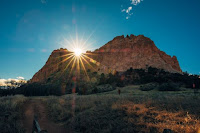Victory over the Devil
Jesus defeated Satan in the wilderness, and the effects of his victory were demonstrated as he exercised authority over demonic forces upon his arrival in Galilee where he began to proclaim the Good News – “Repent, for the Kingdom of God is near!” For, in Jesus of Nazareth, “The people that sat in darkness Saw a great light. And to them that sat in the region and shadow of death, to them did light spring up.” With the appearance of the “Son of Man,” the era of salvation had commenced.
All this began in the village of Capernaum on the northwest shore of the Sea of Galilee. And his
first confrontation with the now-defeated forces of Satan took place in the local
synagogue - (Mark 1:21-28).
 |
| [Photo by Andrew Seaman on Unsplash] |
The term ‘synagogue’ means “gathering place,” typically, an assembly hall where Jews studied the Torah and prayed. This institution is not mentioned in the Torah, and it possibly originated during the Babylonian Captivity.
HIS TEACHING STYLE
In the
synagogue, the Jews were amazed by the authoritative manner by which Jesus taught,
but NOT by the contents of his teaching. The scribes expounded the Law by citing oral traditions and legal
precedents, the so-called “tradition of the elders.” They did not make authoritative
pronouncements on scriptural interpretations, at least, not on their own
authority.
In contrast, Jesus taught decisively with practical and relevant applications based on his messianic authority. The “Son of Man” had arrived, and he possessed the messianic authority to pronounce the correct interpretations of Scripture.
Of the
thirteen miracles recorded in the Gospel of Mark, four are exorcisms, the
most frequent type of healing in this gospel account. Eleven times Mark
refers to demons as “unclean spirits.” Four times the verbal form of the
Greek term for “demons” is used to denote someone who is “demonized.”
In other words, oppressed by demons.
In the
present account, the term “unclean” refers to a state of ritual defilement. A person
with an “unclean spirit” was excluded from the Jerusalem Temple and its
various worship and sacrificial rituals unless he or she underwent the required
steps to reestablish his or her ritual purity.
IN THE SYNAGOGUE
But why was
this demonized man allowed in the synagogue despite his ritually “unclean”
state? His very presence indicated that the members of the synagogue did not
rigorously follow the purity codes found in the Book of Leviticus, or at
least, not the men present in the synagogue that day.
In Mark,
the synagogue is the place where demons are present, religious authorities
are antagonistic to the Messiah, and their hardness of heart is the rule rather
than the exception. Like the Temple, the synagogue is an arena of conflict
whenever Jesus begins to proclaim the Good News of the Kingdom of God - (Mark
1:39, 3:1, 6:2, 12:39, 13:9).
This demon
spoke through the man: “What have we in common with you, Jesus of Nazareth?
Have you come to destroy us?” The unclean spirit used the plural pronoun “we”
since he represented all demonic forces that were present in the synagogue. The
confrontation was a harbinger of the larger cosmic conflict between Jesus and
the forces of Satan that would culminate in his death.
This “unclean
spirit” recognized this unassuming Jesus of Nazareth as the “Holy One of
God,” the promised Messiah of Israel. Though hidden from men, the demons knew
who he was. His command for them to remain silent was not to hide his messianic
status. By identifying him in public as the Messiah, demons could discredit his
teachings and mission.
And in Mark’s account, more than the content of his teachings, what matters is the way in which he teaches - “WITH AUTHORITY” - and its effect on those who hear him (“They were all amazed”).
Thus, the words
of Jesus demonstrated his superior authority over those of the scribes, and his
exorcisms evidenced his authority over the Devil. The authority by which he taught
was the same messianic authority by which he expelled demonic forces.
His exorcisms
proved that the “Coming One” who will baptize his followers in the Holy
Spirit is reconquering territory from Satan’s realm and adding it to the
Kingdom of God. His authority over demonic forces was the result of his victory
over Satan and his return “in the power of the Spirit.”


Comments
Post a Comment